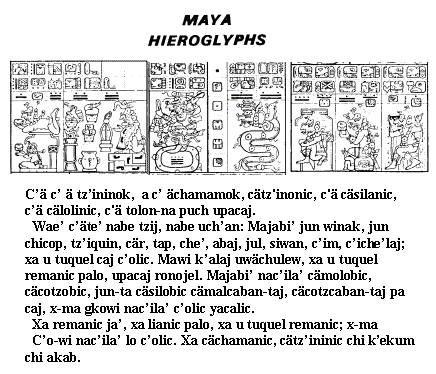Language Information
Maya, the language of the great Maya civilization that flourished more than a thousand years ago, is still spoken in various forms by several million people in present-day Mexico, Guatemala, and British Honduras. Since earliest times the Maya language has contained numerous dia1ects, which today are sufficienily different to be regarded as separate languages. There are about eight such languages in Mexico and more than a dozen in Guatemala.
Maya proper, sometimes called Yucatec, is spoken by about 450,000 people on the YucatAn Peninsula of Mexico as well as in northern British Honduras. In the adjacent Mexican states of Chiapas and Tabasco, there are, from south to north, Tzotzil (100,000 speakers), Tzeltal (100,000), Chol (50,000), and Chontal (20,000). Farther up the coast, in Veracruz, and inland in San Luis Potosi, Huastec is spoken by about 150,000 people. In Guatemala, which has about 3 million Maya Indians, the big four languages are Quiché (1 million speakers), Cakchiquel (500,000), Mam (250,000), and Kekchi (250,000). Kekchi is also spoken in southwestern Belize.
The Popul Vuh, the sacred book of the Mayas, is a stirring account of Maya history and traditions, beginning with the creation of the world. The most outstanding example of native American literature that has survived the passing of centuries, it was first reduced to writing (in the Roman alphabet) in the middle of the 16th century.
Alone among the Indians of America, the Mayas possessed a fully developed system of writing. The Maya hieroglyphs, a sample of which appears at the right, have posed a formidable challenge to scholars and linguists ever since the 16th century. They appear to be a combination of ideographs, phonetic signs, and also rebus writing, in which an ideograph is used to represent another word which happens to have the same pronunciation. (For example, in En-glish the sign for 'eye" could be used to represent the pronoun "I.") The first signs to be deciphered were those dealing with the calendar and astronomy, but progress in unravel-ing the rest of the system has been extremely slow and difficult. Even electronic computers have been ap-plied to the problem in recent years, and new discoveries offer fresh hope that the mystery will eventually be solved.
Maya (Quiche) is spoken/used in the following countries:
Belize (British Honduras), Guatemala, Mexico.
Language Family
 Family: North American Indian
Family: North American Indian
 Subgroup: Mayan
Subgroup: Mayan
Copyright © Kenneth Katzner, The Languages of the World, Published by Routledge.
Writing Sample

Translation
This is the account of how all was still, the waters lay calm, there was no wind, and the expanse of the sky was empty.
This is the first account, the first narrative. There was neither man nor animal, birds, fish, crabs, trees, stones, caves, ravines, grasses, nor forests; there was only the sky. The surface of the earth had not appeared, there was only the calm sea and the great expanse of the sky. There was nothing brought together, nothing which could make a noise, nor anything which might move, or tremble, or fly, nor was anything standing.
There was only the calm water, the placid sea, alone and tranquil; nothing whatever existed. Only the expanse of water, and tranquillity in the darkness, in the night.
Popul Vuh
|


